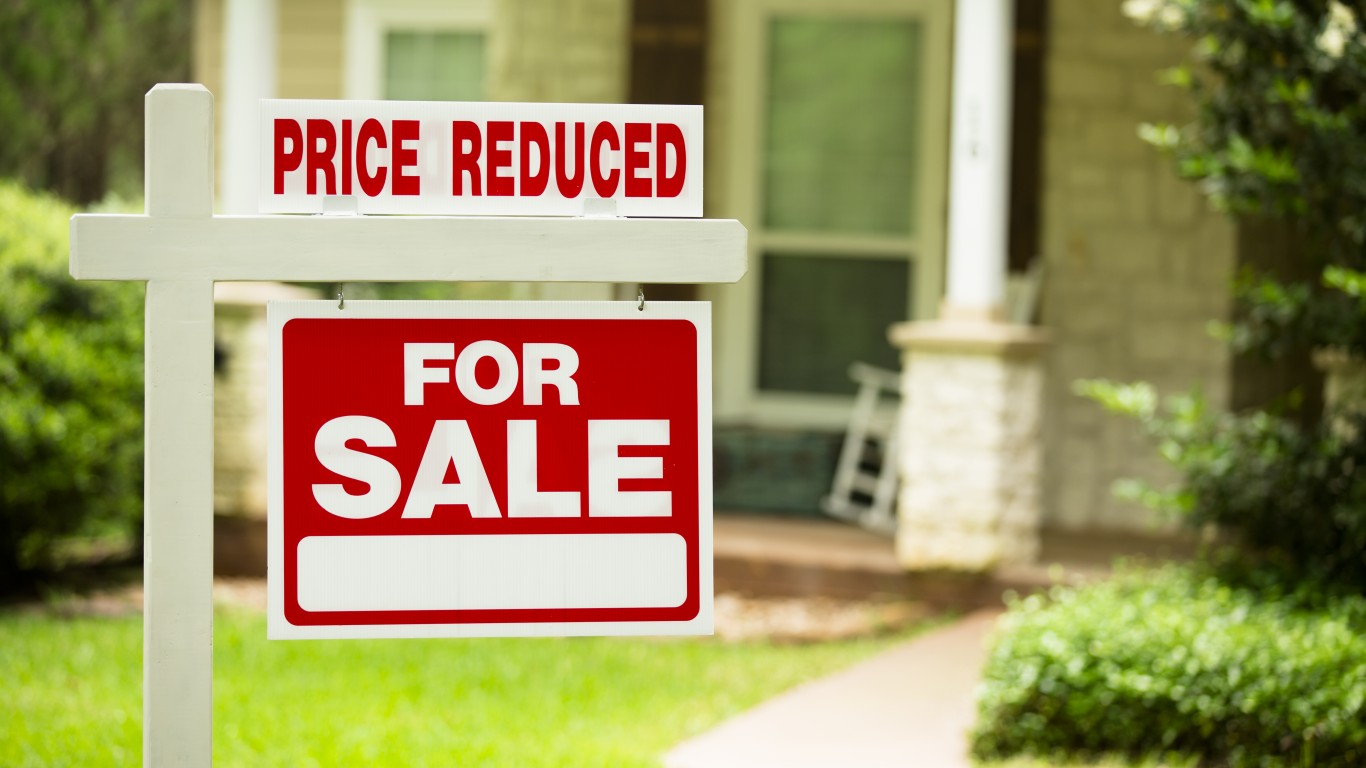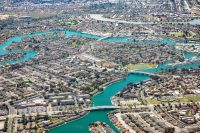 The advantages of small-town living are well known to Americans — and not just because of Norman Rockwellesque clichés about values, neighborliness and pace of life. These days, most prosperous small towns are bedroom communities with good public schools and easy commutes to large employment centers.
The advantages of small-town living are well known to Americans — and not just because of Norman Rockwellesque clichés about values, neighborliness and pace of life. These days, most prosperous small towns are bedroom communities with good public schools and easy commutes to large employment centers.
Read: Small Towns with Soaring Housing Markets
Have small-town housing markets bounced all the way back to prehousing crisis levels? Not just yet. But based on data provided by Zillow, a leading provider of real estate listings and market data, 24/7 Wall St. was able to identify small towns that have demonstrated strong signs of a healthy recovery in the past year.
Some of the large year-over-year increases are the result of a market correction, believes Louise Keely, senior vice president at Nielsen’s The Demand Institute, a leading provider of consumer behavior data. “Prices went down too much, and now the market is moving back to an equilibrium,” Keely told 24/7 Wall St. “I would expect a leveling out, and housing price growth nationally is going to be in the low single digits.”
Small towns will stay competitive with larger nearby communities, Keely says. “Small towns tend to have lower home prices than nearby urban areas, and that will make them more attractive for households with weaker household balance sheets than they were 7 to 10 years ago.”
As part of the greater Phoenix metro area, Florence suffered during the recent housing bust but is now staging a significant comeback. However, according to Prof. Mark Stapp, who runs the Masters of Real Estate Development program at Arizona State University’s W.P. Carey School of Business, the recovery is a bit misleading.
“We lost so much value in housing that the increase in price is driven off of a very low base,” cautions Prof. Stapp. “What you’re seeing is increases in prices off of a historic low — so it’s a bit deceiving because it’s not a sustainable growth rate. But I don’t think you’re going to see prices fall.”
No doubt, small towns will see their fair share of the recovery. A study by the National Association of Home Builders indicates that builder confidence is the highest it has been since June 2006. NAHB projects increased demand for new homes, which not only addresses buyer demands, but also the additional housing stock helps slow the rate of home price increases.
24/7 Wall St. identified the 10 small towns with the fastest rising housing prices based on Zillow housing data. We defined small towns as having between 30,000 to 50,000 residents. To be considered, the small town had to have the highest year-over-year growth through August 2012. Because several metropolitan statistical areas (MSA) included more than one small town with the fastest growing housing market, we only considered the small town in each MSA with the fastest growth.
These are the small towns with booming housing markets.
10) Parkersburg, W. Va.
> 1-yr. home price change: 8.8%
> MSA (metropolitan statistical area): Parkersburg, Va.
> Population: 48,993
> Median home value: $71,400
Parkersburg may be small by many standards, but it is the third-largest city in West Virginia. The city, in close proximity to the Ohio River, is a regional tourist destination known for well-preserved, historic buildings. A recent announcement of new federal jobs has local real estate professionals buzzing about the expected economic boost. Almost all of the city’s housing price growth has come in the past quarter, as home prices rose by 6.3% in the past four months. The median home price in the region, estimated by Zillow at just $71,400, is less than half the U.S. median of $152,100.
9) Culpeper, Va.
> 1-yr. home price change: 9.4%
> MSA (metropolitan statistical area): Culpeper, Va.
> Population: 30,204
> Median home value: $172,100
If you’re a Civil War history buff, odds are you will pass through Culpeper, at least on your way to other significant battlefields in Virginia. The area is considered a desirable and affordable bedroom community for employees of companies in the Washington D.C. suburbs. While home prices are up by 9.4% in the past year, and by 5% in the past quarter alone, they are down slightly from last month.
Also Read: Ten Towns That Cannot Turn Around
8) Papillion, Neb.
> 1-yr. home price change: 11.3%
> MSA (metropolitan statistical area): Omaha, Neb.
> Population: 35,558
> Median home value: $191,500
This Omaha suburb, named the third-best place to live in America in a 2009 Money Magazine survey, recently opened its doors to a Triple-A minor league baseball team, the Omaha Storm Chasers. The city also boasts a more than 36% increase in property value in the past nine years. Since 1980, the city’s population has more than doubled. Its current median home price of $191,500 is higher than any town or city in Omaha.
7) Edina, Minn.
> 1-yr. home price change: 12.0%
> MSA (metropolitan statistical area): Minneapolis-St. Paul, Minn.
> Population: 49,336
> Median home value: $344,300
Edina is considered an upscale suburb of the Twin Cities. It has a lone public high school, which is considered one of the nation’s best with its high graduation rates. Though small, the city’s median income is well above state levels. The city is also home to a number of corporate headquarters, including those of the parent of Supercuts, Regis Corp. (NYSE: RGS), as well as Dairy Queen. The median home price has risen by 1.2% in the past month compared to a 0.1% decline nationwide.
6) Walla Walla, Wash.
> 1-yr. home price change: 12.8%
> MSA (metropolitan statistical area): Walla Walla, Wash.
> Population: 40,845
> Median home value: $167,400
This small, southern Washington city with an unforgettable name is a mostly agricultural community that is enjoying the fruits of a wine boom, as there are more than 100 wineries in the area. Locals are adjusting to a recent influx of wine tourists, foodies and rising home prices. While home prices are up by 12.8% in the city, they have leveled off in the past few months. The median price is up by just 0.3% in the past month, and is unchanged compared to last quarter.
5) Menlo Park, Calif.
> 1-yr. home price change: 13.4%
> MSA (metropolitan statistical area): San Francisco, Calif.
> Population: 40,795
> Median home value: $1,169,600
This affluent suburb on the edge of Palo Alto, Calif. is home to many venture capital companies that are helping to fuel the current IPO and tech boom in Silicon Valley. The biggest local employer is Facebook (NASDAQ: FB), although the social network’s post-IPO performance has failed to meet expectations, some of the wealth it generated appears to have stayed close to home. The average home price in the suburb is more than 7.5 times the U.S. median.
4) Kendall West, Fla.
> 1-yr. home price change: 13.7%
> MSA (metropolitan statistical area): Miami-Fort Lauderdale, Fla.
> Population: 39,742
> Median home value: $101,800
Housing prices in this mostly working-class and unincorporated Miami suburb have shown resiliency in the face of a housing downturn that inflamed much of the state in recent years. Home prices here have managed to outpace state averages and double since 2000, despite the downturn. Despite a nearly 14% growth in home prices in the past year, estimated home prices barely exceed $100,000, and are roughly $50,000 less than the U.S. median home price for August.
Also Read: The 10 States with the Strongest Housing Markets
3) Saratoga, Calif.
> 1-yr. home price change: 14.4%
> MSA (metropolitan statistical area): San Jose, Calif.
> Population: 31,102
> Median home value: $1,620,200
Local lore has it that IPOs by LinkedIn (NYSE: LNKD), Facebook, Zynga (NASDAQ: ZNGA) and other tech companies have given a strong push to housing markets in Silicon Valley, which encompasses much of the Peninsula north of San Jose. There appears to be increasing competition among buyers vying for a constrained housing supply in this upscale suburb. The estimated home value in Saratoga — $1.6 million — is the second highest in the country for any town or city with at least 30,000 residents, behind only Beverly Hills.
2) Northville Township, Mich.
> 1-yr. home price change: 15.7%
> MSA: Detroit, Mich.
> Population: 35,300
> Median home value: $268,700
This upper-middle class Detroit suburb is buoyed by a high-performing school district that helped sustain property values amid challenging economic times for Michigan. The school district tips its cap to its constituent demographics: “The majority of the community is employed in middle and upper management positions with the auto industry and subsidiaries or professional occupations.” Home prices in many Detroit suburbs have grown in value in the past year, including such larger areas as West Bloomfield and Utica. Northville is one of the more expensive communities among them. The median home value in the town exceeds the average Detroit neighborhood by more than $110,000.
1) Florence, Ariz.
> 1-yr. home price change: 21.8%
> MSA (metropolitan statistical area): Phoenix, Ariz.
> Population: 30,880
> Median home value: $115,300
Home prices in Florence are recovering amid surging demand from an influx of new residents in the area. The town’s population has risen by nearly 50% since 2010. Amid the downturn, new home construction declined sharply in the greater Phoenix area, a factor that helped to constrain home prices during the housing crisis. Despite the 21.8% increase in the past year, home values are still more than $35,000 under the national median.
-By Rusty Weston
Also Read: Cities with the Most Homes in Foreclosure
Travel Cards Are Getting Too Good To Ignore
Credit card companies are pulling out all the stops, with the issuers are offering insane travel rewards and perks.
We’re talking huge sign-up bonuses, points on every purchase, and benefits like lounge access, travel credits, and free hotel nights. For travelers, these rewards can add up to thousands of dollars in flights, upgrades, and luxury experiences every year.
It’s like getting paid to travel — and it’s available to qualified borrowers who know where to look.
We’ve rounded up some of the best travel credit cards on the market. Click here to see the list. Don’t miss these offers — they won’t be this good forever.
Thank you for reading! Have some feedback for us?
Contact the 24/7 Wall St. editorial team.



